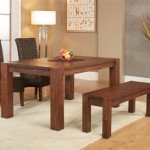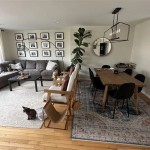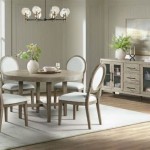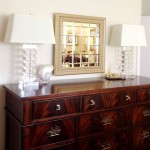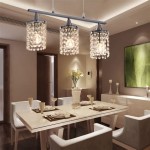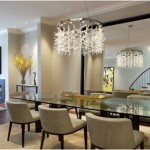Kitchen Dining Room Color Ideas: Harmonizing Function and Style
The kitchen and dining room often function as the heart of a home, serving as spaces for culinary creation, shared meals, and social gatherings. Selecting the appropriate color palette for these interconnected areas is crucial for establishing a welcoming, functional, and aesthetically pleasing environment. Thoughtful consideration of color psychology, spatial dimensions, available lighting, and personal style preferences is essential for achieving a cohesive and satisfying result.
When considering color schemes, one must remember that color profoundly affects mood. Warm colors like reds, oranges, and yellows can stimulate appetite and create a sense of energy and sociability. Conversely, cool colors such as blues, greens, and purples can evoke feelings of calmness and relaxation. Neutral tones, including whites, grays, and beiges, provide a versatile backdrop that allows for the incorporation of bolder accents through accessories, artwork, and textiles.
The interplay between natural and artificial light also significantly influences the perception of color. Rooms with abundant natural light can generally accommodate darker or more saturated colors without feeling oppressive. Conversely, spaces that rely heavily on artificial lighting may benefit from lighter hues that reflect light and create a brighter ambiance. Similarly, the size and layout of the kitchen and dining room should inform color choices. Smaller spaces often appear larger when painted in light, airy colors, while larger rooms can handle more dramatic or contrasting schemes.
Understanding the Impact of Color Psychology
Color psychology explores the emotional and psychological effects that colors have on individuals. Applying these principles to kitchen and dining room design can enhance the overall dining experience. For instance, a vibrant red accent wall in the dining room might stimulate conversation and create a celebratory atmosphere. However, an excessive use of red could become overwhelming, potentially leading to feelings of restlessness or anxiety.
Yellow, often associated with happiness and optimism, can be an excellent choice for brightening up a kitchen, especially in areas that receive limited sunlight. However, certain shades of yellow can appear artificial or cloying if not carefully selected. Orange, a blend of red and yellow, combines the energy of red with the cheerfulness of yellow. It can be used judiciously to create a warm and inviting atmosphere, particularly in transitional areas between the kitchen and dining room.
Cool colors, such as blue and green, are often associated with tranquility and serenity. Light blues and greens can create a refreshing and airy feel in the kitchen, promoting a sense of calm during meal preparation. Darker shades of blue and green can add sophistication and depth to the dining room, creating a more formal and refined ambiance. However, it is important to balance cool colors with warmer accents to prevent the space from feeling cold or impersonal.
Neutral colors, such as white, gray, and beige, offer a versatile foundation for any kitchen and dining room color scheme. White reflects light effectively, making it ideal for small or poorly lit spaces. It also provides a clean and minimalist backdrop that allows for the incorporation of various accessories and decorative elements. Gray, ranging from light silver to deep charcoal, offers a sophisticated and contemporary alternative to white. Beige provides a warmer and more inviting neutral option, creating a cozy and comfortable atmosphere.
Key Color Combinations for Kitchen and Dining Room Spaces
Selecting the right color combination can elevate the aesthetic appeal of the kitchen and dining room, creating a harmonious and visually stimulating environment. One can consider both monochromatic and complementary combinations depending on the desired effect.
A monochromatic color scheme utilizes different shades, tints, and tones of a single color. For example, a kitchen might feature light gray walls, darker gray cabinetry, and stainless steel appliances. This creates a cohesive and sophisticated look, but it is important to introduce texture and variation to prevent the space from feeling monotonous. Using different materials, such as wood, stone, and metal, can add visual interest to a monochromatic scheme.
Complementary color schemes employ colors that are opposite each other on the color wheel. For instance, blue and orange, or red and green. These combinations create a high level of contrast and visual excitement. However, it is important to use complementary colors carefully to avoid overwhelming the space. Typically, one color is used as the dominant hue, while the other is used as an accent.
Analogous color schemes use colors that are adjacent to each other on the color wheel, such as blue, blue-green, and green. This creates a harmonious and balanced look. Analogous schemes are generally easier to work with than complementary schemes, as they naturally create a sense of visual unity. Using different values and intensities of the colors can further enhance the overall effect.
Neutral color schemes can be enhanced by adding pops of color through accessories, artwork, and textiles. For instance, a kitchen with white walls and gray cabinets can be enlivened with colorful dishware, vibrant artwork, and patterned rugs. This allows for flexibility in changing the color scheme over time, as the neutral base remains constant.
In addition to solid colors, consider incorporating patterns and textures to add visual interest to the kitchen and dining room. Patterned wallpaper, tiled backsplashes, and textured fabrics can create depth and dimension, enhancing the overall aesthetic appeal. However, it is important to use patterns sparingly to avoid overwhelming the space.
Integrating Color with Kitchen and Dining Room Elements
Color selection is not just about the walls; it is also about how the colors interact with the other elements in the room, such as cabinetry, countertops, flooring, and appliances. The color scheme should be carefully considered in relation to these elements to create a cohesive and harmonious design.
Cabinetry often forms a significant element of the kitchen's visual landscape. White cabinets are a classic choice, offering a clean and timeless look that complements various color schemes. Gray cabinets provide a more sophisticated and contemporary alternative, while wooden cabinets add warmth and natural beauty. The color of the cabinets should be carefully considered in relation to the wall color, countertop material, and flooring to create a balanced and cohesive look.
Countertops also play a significant role in the overall color scheme. Dark countertops, such as black granite or dark quartz, can create a dramatic contrast against light cabinetry and walls. Light countertops, such as white marble or light quartz, can brighten up the space and create a sense of airiness. The color of the countertop should be carefully selected to complement the cabinetry, backsplash, and flooring.
Flooring is the foundation of the kitchen and dining room design, and its color can significantly impact the overall ambiance. Light-colored flooring, such as white tile or light wood, can make the space feel larger and brighter. Dark-colored flooring, such as dark wood or dark tile, can add warmth and sophistication. The color of the flooring should be carefully considered in relation to the cabinetry, countertops, and walls.
Appliances also contribute to the overall color scheme. Stainless steel appliances are a popular choice, offering a sleek and modern look. White appliances provide a classic and timeless alternative, while black appliances add a touch of drama. The color of the appliances should be carefully considered in relation to the cabinetry, countertops, and flooring.
Finally, consider the architectural style of the home when selecting a color scheme. A traditional home might benefit from warmer and more classic colors, while a modern home might be better suited to cooler and more contemporary hues. The color scheme should complement the overall architectural style to create a cohesive and harmonious design.

52 Best Kitchen Paint Color Ideas And Combinations For 2025

86 Designer Approved Kitchen Paint Color Ideas For 2025

37 Kitchen Paint Ideas That Will Revitalize Your Space
:max_bytes(150000):strip_icc()/MaryPatton_May2020-6-8e9f410c0f1d4fe28484853ea47b1d5c.jpg?strip=all)
40 Perfect Dining Room Colors For Any Style

8 Best Kitchen And Dining Room Color Scheme Ideas Photos

The Best Dining Room Paint Colors

86 Designer Approved Kitchen Paint Color Ideas For 2025
:max_bytes(150000):strip_icc()/erin-williamson-designs-5-c344f3b26f7d49af91c1cb9bf58564d7.jpg?strip=all)
40 Perfect Dining Room Colors For Any Style

26 Kitchen Color Ideas Inspiration To Elevate Your Beamin Moore

How To Choose The Perfect Farmhouse Paint Colors
See Also

